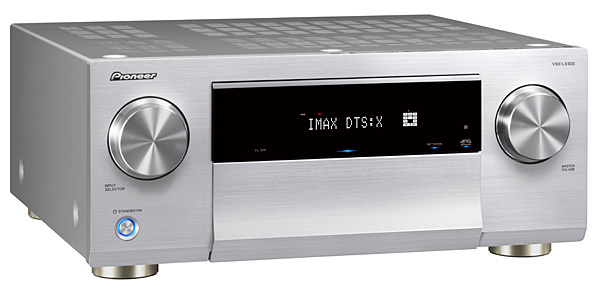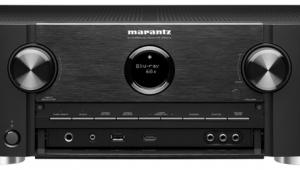Pioneer VSX-LX505 Elite 9.2-Channel A/V Receiver Review Page 2
At the end of the day, the results produced by MCACC sounded very similar to those obtained from Dirac, though I could not make a meaningful comparison since the LX505 only stores one "run" of MCACC or Dirac, at a time; Dirac does, however, provide three memory presets for storing modified versions of the original curve. While I could cheerfully use all of my allotted space to compare and contrast the intricacies of the two systems, my editor would have a fit, so here's my 10-cent summary: casual users will be perfectly happy with a one- or perhaps three-mic-position run of MCACC, while the geeks among us will want to dive fully into the Dirac-verse, possibly even downloading and running the fuller-version Dirac software on a Mac or PC and using a calibrated mic such as the ubiquitous MiniDSP UMIK-1 to measure many more positions. At the end of the day I preferred Dirac, mostly for its customizable house-curve options, but set-and-forgetters will find Pioneer's MCACC system easier to use and fully capable of producing excellent results.
Performance
With setup complete, I surfed and quickly found a convenient streaming presentation of that old action-movie chestnut Jack Reacher, which the Pioneer dutifully up-mixed to Atmos. The presentation was surprisingly satisfying. Gunshots were distinctive—crisp yet deep and accurately spatialized—and dialogue, from whispered mutterings to shouts, was locked on-screen and unfailingly intelligible and natural.

I streamed most of the music I used for critical listening via Roon, disabling MCACC but leaving the two Roon filters I use to mitigate my room's primary low-frequency modes engaged. (This is my usual practice; since every room and setup is different, taking onboard correction systems out of the loop makes base-line sense to me, but subduing my room's influence in a long-known, repeatable way makes for more meaningful judgements.)
I've been a Bonnie Raitt fan since, as a clueless teen. I once opened for her in a tiny church coffeehouse long before she broke nationally (no, I'm not telling when that was). So I was eager to give her new album, Just Like That, a close listen. Streaming it via Tidal/MQA, I was delighted to hear that her voice—still just about the best out there—remains the same powerful, flexible, nuanced instrument, even after a half-century of hard use. The LX505 produced enough power to deliver the album at control-room-playback levels with room to spare. There was no hint of squish or flabbiness on the bottom, even with the receiver in Direct mode, playing full-range stereo with no subwoofer and putting maximum demands on its main left-/right-channel amplifiers.
Just as important, the Pioneer's resolution was high enough to reveal a ghost of an edge on Raitt's vocals on "Something's Got a Hold of My Heart"—presumably a deliberate production choice (I also heard it on high-end HiFiMan headphones running through a separate DAC/headphone-amp)—while delineating her inimitable, moaning, compressed-Strat slide guitar with perfection.
SACD may be a dead, or at least moribund format, but it lives on in my system. I cued up the cherished Telarc recording of Stravinsky's Rite of Spring, again running subwoofer-less to sweat the amp channels as hard as possible, and let the Pioneer up-mix the five channels to height-enabled 9.0. The results did not disappoint. From the opening, birdsong-like bassoon-solo to the violent, club-wielding climax, the Pioneer ably reproduced the breadth and power of this superb recording. I heard no issues on low-end impact, definition, or breadth and depth of the sound as recorded in Cincinnati's Music Hall, and the Atmos embellishment dialed in via the LX505's listening mode options contributed a welcome sense of height to the front-stage "air."
Watching my usual movie trial scenes produced consistently fine results, so I moved on to the reference-standard Bladerunner 2049 and watched it all the way through—something I had, unaccountably, never done before. The undisputed star of the show was Hans Zimmer and Benjamin Wallfisch's brilliant score with its heavy electronica, frequently arresting spatial tricks, and deep and powerful bass, produced in full by the LX505. I switched on the MCACC EQ calibration and, amazingly, the sound was utterly perfect without any touchups of balance or subwoofer level—something that happens very rarely. This is one of the most heavily spatial soundtracks I know, and the LX505 delivered it seamlessly through my nine speakers, with smooth, consistent pans and a convincing but not overblown sense of height.
In sum, whether I was playing music or watching movies, I had no complaints about the receiver's sonic delivery.
Hands On
Of course, there's a lot more to an AVR than its sound and visual delivery, however excellent. Like virtually every competing model, the Pioneer LX505 is drowning in features and functions, far too many to cover here, so allow me to cherry pick a few to highlight.
I'll begin with a complaint. The pokey remote Pioneer supplies was a disappointment (its Onkyo sibling gets the same one). Sure, the Pioneer Remote app is free and a vastly superior alternative, but hey—this is a $1,500 component. The good news: apart from those cheesy speaker terminals, that was the only serious gripe I could muster, and the Remote app, downloaded to my iPad, proved a pleasure to use for streaming and most everything else.

There's much to like, starting with the Personal Preset feature that lets you establish three one-touch presets for storing combinations of source, output, and listening mode (but not channel balances, unfortunately). With 24-bit/192kHz-capable digital-to-analog hardware, the LX505 is ready for hi-resolution streaming from apps or an external server. In a quick comparison, hi-rez files streamed via the TwonkyMedia server residing on my iMac and through my excellent Roon-ready standalone DAC were indistinguishable.
The list of features goes on and includes onboard apps for Tidal, Spotify, Pandora, and Amazon but not Qobuz (my preference) and an IMAX Enhanced mode in addition to the requisite Dolby Atmos and DTS:X surround processing. The receiver also supports HDMI with eARC (enhanced Audio Return Control), which worked without fuss or delay when connected to my Sony OLED TV, flowing Atmos and all other surround formats without incident, something that has not always been the case in my experience.
Lastly, for the truly tech-obsessed (and custom installers), the Pioneer has a web-setup interface: enter the IP address shown on the Network setup page into your browser and you get a page with basic setup and control functions. To which I'll add an Easter egg: enter "ciuser" for the login and password, instead of the default "admin/admin," and you gain access to a vastly more complete set of controls, including a few esoteric items not even accessible via the supplied remote or free app.
Conclusion
TMI? Probably. So let me leave you with this: I liked the Pioneer VSX-LX505 a good deal. I think it's a fairly priced, near-state-of-the-art audio/video receiver. AV-ers seeking performance and function over more subjective variables like looks or brand-cachet are likely to be very satisfied.





























































